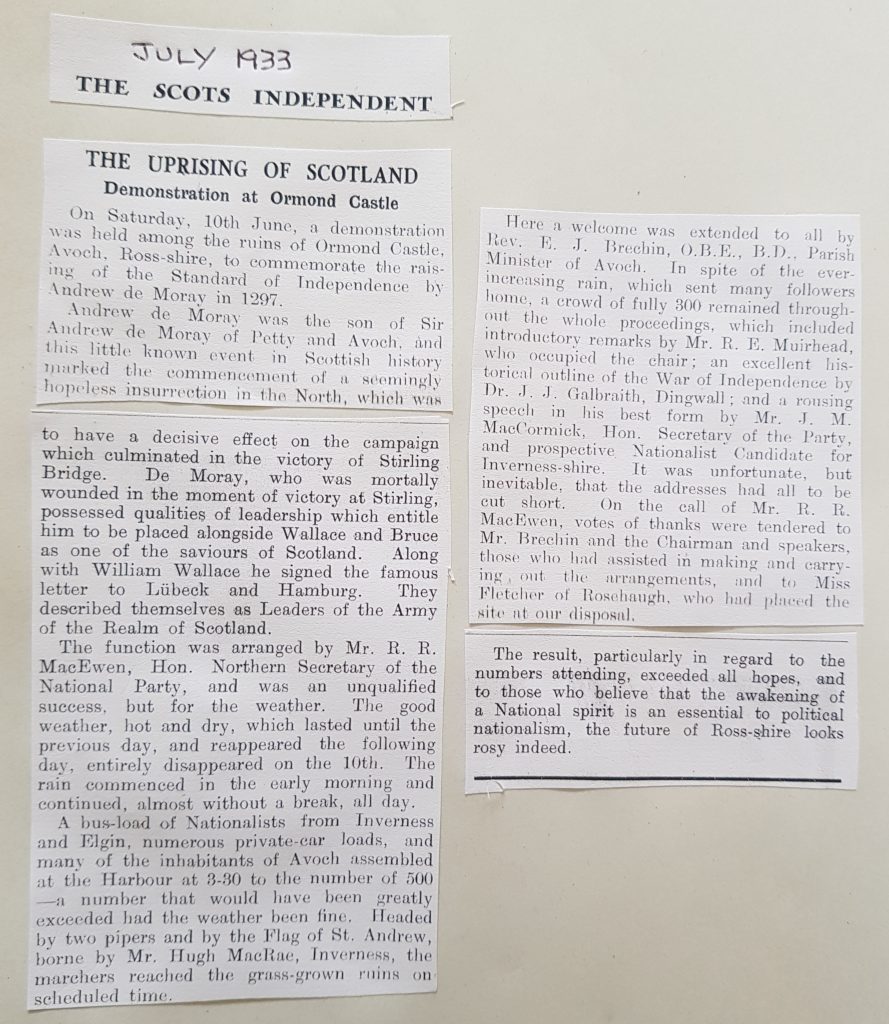The Andrew de Moray Project was created to celebrate the 700th anniversary of Andrew de Moray’s 1297 North Rising. Each year in May we rally at Ormond Hill, Avoch in the Black Isle where a new Saltire is hoisted on the flagpole on the cairn which we built and was first unveiled in 1997.
We are pleased to continue that old community tradition started in the 1930s. In 2024 our march and flag raising at Ormond Hill takes place on Saturday afternoon 18th May.

You can celebrate the fame of a Scottish hero whose castle at Ormond Hill was the base for his successful guerrilla war in 1297 against the local allies of Edward 1 of England. Andrew became co-commander of the Army of Scotland with William Wallace at the victorious battle of Stirling Bridge. His early death from wounds hid him from historical view. This was retrieved by Evan Macleod Barron in his 1914 book The Scottish War of Independence. It confirmed the key role of the North Rising.
What we know of events in 1297
To Edward I in South East England the abject surrender of Scotland seemed complete after the Scots lords’ disaster at Dunbar in 1296. They had to sign what’s known as the Ragman’s Roll. The absence from the list of the knightly Wallace family of Elderslie near Paisley was later noted.
With so many earls and barons imprisoned who would dare disturb the English King’s peace? Yet, unrest was simmering in various places and the Scottish Church was organising resistance. Also the heir to Petty, Avoch, Boharm, Arturlie, Croy and Botropine, Andrew de Moray, had just escaped from Chester Castle and returned to his extensive domains which stretched from the Black Isle to Banff-shire.
He raised the standard of King John Balliol at his father’s castle at Avoch, in May 1297. Unoccupied by English forces it proved an ideal base to rally his people. A leading Inverness merchant, Alexander Pilche brought many people across the Firth to join Andrew’s feudal levies. Their small army of foot soldiers then decided on very different tactics from pitched battles like Dunbar. Instead they plumped for hit and run tactics.
By late May 1297 Sir Reginald le Chen, keeper of Inverness Castle, wrote to King Edward seeking reinforcements. He had called a council of war of loyal lords. The reluctant Countess of Ross attended, as did Fitzwarine, the Constable of Urquhart Castle. Edward had ordered them to crush the rebels.
Fitzwarine’s armed guard was ambushed on the Caiplich outside Inverness on the old track high above Loch Ness which led to Glen Urquhart. Several of the English guard were killed, cavalry lost their mounts and Moray’s men won their first skirmish. However Fitzwarine escaped to the safety of Castle Urquhart.
The appearance of a third force led by the Countess of Ross at Glen Urquhart caused suspicion on both sides. Andrew called on Fitzwarine to surrender; a messenger from the Countess offered the English safe conduct and later provisions. Andrew’s men were repulsed in a night attack while the Countess’s force stayed well clear.
The unbeaten Scottish patriots were elated by success, news of which spread like wildfire. Though they had suffered a few casualties they were undaunted against potentially huge odds. De Moray and Pilche quickly captured the Countess’s castle at Balconie, near Evanton, dividing their enemy’s forces in the area.
History revealed and celebrated
It was Evan MacLeod Barron in his 1914 book who drew attention to the huge effects of the North Rising at that critical time of national revolt. He concluded, “At all events it is clear that Andrew de Moray’s campaign was the direct cause of the (subsequent) Aberdeenshire rising, and with that rising English power in the north east collapsed like a pack of cards”.
As is now well known, Moray and Wallace together led the Army of Scotland in September 1297 to a famous victory at Stirling Bridge but Moray died of his wounds as was forgotten for centuries.
Since 1997 the Andrew de Moray Project also works with friends from the Society of William Wallace and share with them, in the Guardians’ Trust, the scheme to create a huge ‘brothers in arms’ memorial at Stirling Bridge for Moray and Wallace.
The Project welcomes support and new members. We are a Scottish registered charity. Please contact our Organiser Charlie Beattie charliejacobite@gmail.com who has a stock of T shirts, badges and pamphlets for sale.
John Robertson

